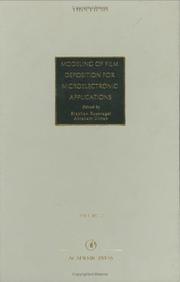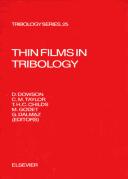| Listing 1 - 10 of 1090 | << page >> |
Sort by
|
Book
Year: 2020 Publisher: Basel : MDPI - Multidisciplinary Digital Publishing Institute,
Abstract | Keywords | Export | Availability | Bookmark
 Loading...
Loading...Choose an application
- Reference Manager
- EndNote
- RefWorks (Direct export to RefWorks)
The Special Issue "Synthesis and Modification of Nanostructured Thin Films" highlights the recent progress in thin film synthesis/modification and characterization. New methods are reviewed for the synthesis and/or modification of thin films based on laser, magnetron, chemical, and other techniques. The obtained thin nanostructures are characterized by complex and complementary techniques. We think that most of proposed methods can be directly applied in production, but some others still need further elaboration for long-term prospective applications in lasers, optics, materials, electronics, informatics, telecommunications, biology, medicine, and probably many other domains. The Guest Editor and the MDPI staff are therefore pleased to offer this Special Issue to interested readers, including graduate and PhD students as well as postdoctoral researchers, but also to the entire community interested in the field of nanomaterials. We share the conviction that this can serve as a useful tool for updating the literature, but also to aid in the conception of new production and/or research programs. There is plenty of room for further dedicated R&D advances based on new instruments and materials under development.
Book
Year: 2021 Publisher: London, England : IntechOpen,
Abstract | Keywords | Export | Availability | Bookmark
 Loading...
Loading...Choose an application
- Reference Manager
- EndNote
- RefWorks (Direct export to RefWorks)
Thin films can be used for a variety of applications. The engineering of thin films is complicated by the fact that their physics is not well understood. The vast varieties of thin film materials, their deposition, processing and fabrication techniques, optical characterization probes, physical properties, spectroscopic characterization, and properties-structure relationships are the key features of such devices and the basis of thin film technologies. Depending on the desired properties, several techniques have been developed for the deposition of thin films of metals, alloys, ceramics, polymers, and superconductors on a variety of substrate materials. The book describes several principles and applications.
Book
ISBN: 1803564563 Year: 2023 Publisher: London : IntechOpen,
Abstract | Keywords | Export | Availability | Bookmark
 Loading...
Loading...Choose an application
- Reference Manager
- EndNote
- RefWorks (Direct export to RefWorks)
A thin film is a layer of material ranging from fractions of a nanometer to several micrometers in thickness. Thin films have been employed in many applications to provide surfaces that possess specific optical, electronic, chemical, mechanical and thermal properties. Through ten chapters consisting of original research studies and literature reviews written by experts from the international scientific community, this book covers the deposition and application of thin films.
Thin films. --- Ferroelectric thin films. --- Zinc oxide thin films.
Multi
ISBN: 9780323374668 0323374662 0323371256 9780323371254 Year: 2016 Publisher: Amsterdam, [Netherlands] : William Andrew,
Abstract | Keywords | Export | Availability | Bookmark
 Loading...
Loading...Choose an application
- Reference Manager
- EndNote
- RefWorks (Direct export to RefWorks)
Manufacturing and Novel Applications of Multilayer Polymer Films discusses the advancements in multilayer technology, including its capability to produce hundreds of layers in a single film by a melt coextrusion process. These engineered films can have significantly enhanced performance properties, allowing films to be made thinner, stronger, and with better sealing properties. As recent developments in feedblocks and materials have opened up a range of new possibilities, this book discusses different feedblocks, and viscosity and material considerations. It is the first comprehensive summary of the latest technology in multilayer film processing and related applications, and is written from a practical perspective, translating research into commercial production and real world products. The book provides fundamental knowledge on microlayer coextrusion processing technology, how to fabricate such structures, structure and properties of such microlayers, and potential applications, thus helping research scientists and engineers develop products which not only fulfill their primary function, but can also be manufactured reliably, safely, and economically.

ISBN: 9780125330220 0125330227 Year: 1996 Publisher: [Place of publication not identified] Academic Press Imprint
Abstract | Keywords | Export | Availability | Bookmark
 Loading...
Loading...Choose an application
- Reference Manager
- EndNote
- RefWorks (Direct export to RefWorks)
Physics of Thin Films is one of the longest running continuing series in thin film science, consisting of 22 volumes since 1963. The series contains quality studies of the properties of various thin filmsmaterials and systems. In order to be able to reflect the development of today's science and to cover all modern aspects of thin films, the series, starting with Volume 20, has moved beyond the basic physics of thin films. It now addresses the most important aspects of both inorganic and organic thin films, in both their theoretical as well as technological aspects. Therefore, in order to reflect the modern technology-oriented problems, the title has been slightly modified from Physics of Thin Films to Thin Films.
Thin films. --- Thin films --- Computer simulation
Book
Year: 2015 Publisher: Burlington : Elsevier Science,
Abstract | Keywords | Export | Availability | Bookmark
 Loading...
Loading...Choose an application
- Reference Manager
- EndNote
- RefWorks (Direct export to RefWorks)
The atomic arrangement and subsequent properties of a material are determined by the type and conditions of growth leading to epitaxy, making control of these conditions key to the fabrication of higher quality materials. Epitaxial Growth of Complex Metal Oxides reviews the techniques involved in such processes and highlights recent developments in fabrication quality which are facilitating advances in applications for electronic, magnetic and optical purposes. Part One reviews the key techniques involved in the epitaxial growth of complex metal oxides, including growth studies using reflec
Epitaxy. --- Thin films -- Surfaces. --- Thin films, Multilayered.

ISBN: 1281778990 9786611778996 0080875890 9780080875897 9780444897893 0444897895 9781281778994 6611778993 Year: 1993 Publisher: Amsterdam : Elsevier for the Institute of Tribology, Leeds University and the Institut national des sciences appliquees de Lyon,
Abstract | Keywords | Export | Availability | Bookmark
 Loading...
Loading...Choose an application
- Reference Manager
- EndNote
- RefWorks (Direct export to RefWorks)
The tribological properties of relatively moving surfaces are greatly influenced by thin surface films which are of considerable importance in the design of machine components. From Victorian days when working lubricant films were calculated in tens of micrometres, to today when molecular dynamics simulations and even experiments are beginning to look at nanometre, single molecule thick films, the study of surfaces which is the tribologists' challenge has moved to finer and finer scales. The 66 papers in this volume provide reviews across the tribological field with thin films as their t
Thin films --- Tribology --- Congresses.
Multi
ISBN: 9780128149317 0128149310 9780128149300 0128149302 Year: 2020 Publisher: Amsterdam Elsevier
Abstract | Keywords | Export | Availability | Bookmark
 Loading...
Loading...Choose an application
- Reference Manager
- EndNote
- RefWorks (Direct export to RefWorks)
Multi
ISBN: 0128218452 9780128218457 9780128218570 0128218576 Year: 2020 Publisher: Elsevier
Abstract | Keywords | Export | Availability | Bookmark
 Loading...
Loading...Choose an application
- Reference Manager
- EndNote
- RefWorks (Direct export to RefWorks)
Nano Plating (II): A Metallurgical Approach to Electrochemical Theory and Its Applications to Technology is the result of the author's 50 years of research. The author reviews the vast experimental results of electrochemical phenomena in light of metallurgical knowledge and proposes theories that can give new insights in electrochemical thermodynamics and predict many phenomena in this field. The book complements Tohru Watanabe's previous book on nano-plating published by Elsevier in 2004.

ISBN: 9780080446998 008044699X 9780080480312 0080480314 1281052248 9781281052247 9786611052249 6611052240 Year: 2006 Publisher: Amsterdam ; Boston : Elsevier,
Abstract | Keywords | Export | Availability | Bookmark
 Loading...
Loading...Choose an application
- Reference Manager
- EndNote
- RefWorks (Direct export to RefWorks)
The goal of producing devices that are smaller, faster, more functional, reproducible, reliable and economical has given thin film processing a unique role in technology.Principles of Vapor Deposition of Thin Films brings in to one place a diverse amount of scientific background that is considered essential to become knowledgeable in thin film depostition techniques. Its ultimate goal as a reference is to provide the foundation upon which thin film science and technological innovation are possible.* Offers detailed derivation of important formulae.* Thoroughly cove
| Listing 1 - 10 of 1090 | << page >> |
Sort by
|

 Search
Search Feedback
Feedback About UniCat
About UniCat  Help
Help News
News